Understanding beet sugar vs cane sugar helps consumers make educated choices about their diet.
Discovering the Distinctions in operation and Advantages In Between Beet Sugar Vs Cane Sugar
In the culinary world, the choice in between beet sugar and cane sugar is not simply regarding sweet taste but includes a nuanced factor to consider of taste, application, and impact. While both sugars stem from different plants, each undergoes unique production processes that subtly affect their characteristics and viability for different recipes.
Origins and Production Procedures of Beet and Cane Sugar
Walking stick sugar, on the various other hand, originates from the sugarcane plant, a tropical lawn belonging to Southeast Asia but now grown in exotic areas worldwide. The production of cane sugar starts with the harvesting of cane stalks, which are squashed to launch the juice. This juice is after that boiled to concentrate it, after which it is spun in centrifuges to generate raw sugar crystals. These crystals are more refined to produce the white sugar frequently readily available in stores.

Nutritional Material and Health Considerations

When contrasting the nutritional content of beet sugar and cane sugar, it becomes noticeable that both kinds essentially offer the same calorie worths, with about 16 calories per teaspoon and no substantial nutrient variety. Both sugars, when consumed in excess, can add to raised blood glucose levels, a threat aspect for diabetic issues and other metabolic problems. From a wellness point of view, moderating consumption of any type of type of sugar, whether from beet or cane, is suggested to stay clear of these prospective negative results on wellness.
Flavor Accounts and Culinary Applications
Despite their comparable chemical structures, beet sugar and cane sugar vary discreetly in flavor, which can affect their use in numerous culinary contexts. Cane sugar often lugs a tip of molasses, even in its polished type, providing a cozy, caramel-like touch that boosts baked goods, coffee, and chocolate-based dishes. This slight molasses flavor is especially valued in the cooking industry for including depth to sugary foods and breads. On the other hand, beet sugar is identified by its extremely improved, neutral taste, making it a functional sweetener that does not modify the flavor profiles of recipes. This neutrality is especially advantageous in fragile recipes, such as light pastries, lotions, and some sauces, where the inherent tastes of various other ingredients are meant to stand out. Chefs and food producers could pick one type of sugar over the other based on the preferred taste outcome of their culinary productions.
Environmental Effect and Sustainability
While both beet and cane sugars are obtained from plants, their environmental influences vary considerably due to the distinct approaches of growing and processing needed for each. Sugar beet growing frequently involves considerable mechanization, which can increase fossil gas usage and carbon exhausts.
Additionally, the processing of sugarcane often generates a considerable amount of waste, consisting of bagasse, which, although functional as biofuel, frequently adds to air pollution if burned inefficiently. Sugar beet handling uses even more of the raw materials, causing less waste. Both sectors deal with challenges in minimizing their environmental impacts, but recurring advancements in agricultural techniques and waste administration are intending to improve sustainability.
Economic Factors Affecting the Sugar Industry
The financial characteristics of the sugar industry are substantially affected by global market needs and profession policies. Aspects such as tolls, aids, and international profession contracts play vital duties fit the competitive landscape. In regions where sugarcane read what he said or sugar beet production is subsidized, producers may have a financial advantage that enables them to provide lower costs on the worldwide market. This can produce variations in earnings and market gain access to for manufacturers in nations without such subsidies.
In addition, variations in international demand for sugar, affected by nutritional fads and commercial use in foodstuff, straight influence try this site costs and production levels. beet sugar vs cane sugar. Weather likewise play an essential role, as they can considerably affect plant returns and, consequently, the supply chain. This variability presents a level of economic unpredictability that can cause investment volatility in sugar manufacturing fields, influencing decisions from growing to market technique
Conclusion
Finally, both beet and cane sugar have special high qualities that match various culinary demands. While cane sugar imparts an abundant taste ideal for boosting baked products, beet sugar's neutrality is excellent for lighter meals. Nutritional similarities regardless of, their unique manufacturing procedures and environmental effects our website add intricacy to the choice in between them. Therefore, understanding these distinctions helps cooks and consumers make notified decisions that line up with their health, cooking, and ethical choices.